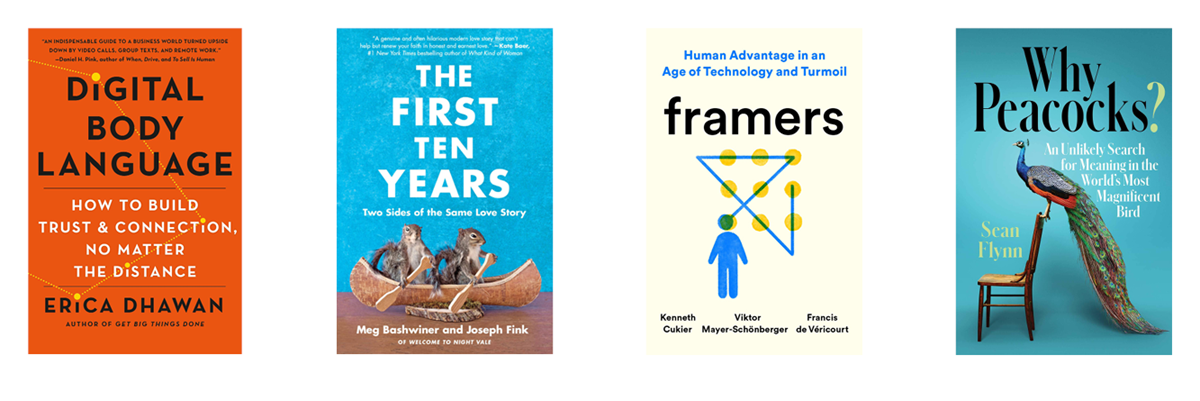Books to Watch | May 11, 2021
May 11, 2021
Each and every week, our marketing team—Editorial & Marketing Director Dylan Schleicher (DJJS) and Creative & Social Media Manager Gabbi Cisneros (GMC)—highlights a few new books we are most excited about.
This week, our choices are:

Digital Body Language: How to Build Trust and Connection, No Matter the Distance by Erica Dhawan, St. Martin's Press
Erica Dhawan’s experience as the child of Indian immigrants helped guide her to a career spanning academia, entrepreneurship, and public speaking. Caught between two worlds, but feeling like she belonged to neither, she was a shy and introverted kid who was acutely attuned to the body language of her classmates at school—and the actors in old Bollywood movies on her family’s VCR after school—for clues. It fostered an interest in nonverbal communication and human connection that she would make her expertise, and that would land this once quiet kid on stages in front of packed rooms across the world.
But what happens when the ability to read nonverbal cues and connect with people in person is cut out by a pandemic? Luckily for Dhawan, she had already begun turning her attention to exactly this issue in response to questions she’d been getting from people in her time working on leadership and collaboration issues in the workplace, where many of the miscommunication issues she was encountering were digital in nature. As she writes in her new book, Digitail Body Language:
I realized that our understanding of body language needed to be redefined for the contemporary workplace. Today we’re all “immigrants” learning a new culture and language, excerpt this time it’s in the digital space. Being a good leader today means not only being aware of other people’s signals and cues but also mastering a new digital body language that didn’t exist twenty years ago …
Online, we are robbed of the cues we get in person—especially simple things like tone of voice—cues that emojis and emoticons can never really replace. What can (at least to begin to) replace them is more deliberate attention to detail in our communication and picking the right communication tools at the right time. Digital Body Language is a great guide to communication in the contemporary workplace, which will rely heavily on digital tools even after the pandemic ends. (To get a headstart on the ideas and strategies Dhawan shares in her book, read her most recent piece for our ChangeThis series.) (DJJS)
The First Ten Years: Two Sides of the Same Love Story by Meg Bashwiner and Joseph Fink, Harper Perennial
“There are so many factors that go into a love story. Factors that are tiny and factors that are monumental, and all of them matter. […] Along with our approaches to life, and our approaches to each other, and our shared years, we also have this: when I wake up for the fifth time that night, and roll over to fall asleep again, Meg doesn’t stir from her sleep. It’s on such tiny miracles that a shared life is built.”
These two authors & podcasters can only be described as an adorkable duo, and even without knowing anything about Welcome to Nightvale, I love everything about this book. It’s far from an overly nostalgic recollection or a search for rekindling the sparks of their youth. It’s more like the two are retracing their steps to better acknowledge and appreciate the many changes in both themselves and the world around them.
I hope The First Ten Years inspires others to retell, relive, and re-examine their own love stories to uncover realizations about how finding one’s way in the world with a partner can, at different moments, be strengthening or draining, and how romance can take many shapes and forms throughout a relationship. (GMC)
Stay tuned for my full book review being posted later this week!
Framers: Human Advantage in an Age of Technology and Turmoil by Kenneth Cukier, Viktor Mayer-Schönberger, and Francis de Véricourt, Dutton
“We do not see things as they are. We see things as we are.” That quote from the Talmud, shared in the final chapter of Framers, gets at the idea that we understand the world only so far as we understand (or imagine) ourselves and our place in it. We don’t perceive the world directly so much as we interpret it through our own mental models—by applying frames to the myriad inputs and stimuli constantly barraging our senses.
Framing helps us both simplify reality and envision other realities to work toward. But our frames don’t always fit, or lead to good outcomes, so we must be deliberate about those we choose. The constitution the framers of our country came up with has been pretty successful so far, in part because it is based on a compromise between two visions of government. The real danger is in dogmatic thinking, ideologically rigid frames, and denying the existence or legitimacy of other ways of thinking. What we need is cognitive freedom, mental agility, and to take advantage of the unique human ability to hold two opposing ideas in our heads (or body politic) at the same time and reframe the problems we face in new and novel ways. Yet, the authors suggest, “We are still susceptible to monolithic thinking, convincing ourselves that past failures of single frames were due to the frame, not because it was singular.” While, in fact:
Uniformity of mental models is what crushes human progress. It makes people no wiser than automata that perpetuate the past, because they cannot see beyond the present. If our frames cannot coexist, how can we?
When looked at in the grand view over the long term, humans today live a much easier, more comfortable, and more pleasant existence than ever before, but we also face our greatest existential challenges as a species, and in order to survive we will need not only cooperation, but a new and diverse set of cognitive frames to think about and act on the problems in front of us—which are many, and largely manmade. The book does not attempt to provide those frames. Rather, it teaches us how to better frame things for ourselves as individuals. (DJJS)
Why Peacocks?: An Unlikely Search for Meaning in the World's Most Magnificent Bird by Sean Flynn, Simon & Schuster
In tandem with The First Ten Years, here is another piece of non-fiction about a creative-minded couple on the East Coast. Both magazine writers, Louise is a Southern girl with an appreciation for Elvis and Flannery O'Conner, and author Sean Flynn specializes in writing about disasters and crimes that have led to the deaths of hundreds of people. After they had children, they moved to a farm in North Carolina and, like many families, decided on adding a pet to their household. However, unlike many families, their pets of choice weren't dogs or cats or rabbits: First it was a ball python, then chicks, and then, because a great horned owl was decapitating peacocks a county over from theirs, they adopted three peacocks for what seems to be a fair price of $125 total.
The story is told so whimsically, appropriate for one whose central characters—named Carl, Ethel, and Mr. Pickle—are regal, iridescent-winged, big-bodied dinosaurs balancing on scaly, clawed feet. With many web searches ("bird vet near me," "how do I build a peacock coop?"), Flynn learns the basics of caring for the birds. And, as he continues his research by traveling across the globe, he finds they are quite significant throughout history: in Eastern tradition "the peacock was an accessory to the gods" and in Christian iconography, "the annual cycle of molting and regrowing an exquisite train was an obvious metaphor for the resurrection, [and] the early Christians adopted the coverts [feathers] with the ocelli [eyes] as a symbol of an all-seeing God."
A wonderfully engaging and educational book, Why Peacocks? Is perfect for fans of H is for Hawk and We Bought a Zoo, even if you're not (yet) a fan of peacocks. Flynn's year-long learning journey of caring for these strange and beautiful birds helps him reflect on humanity and his own life: fatherhood, grief, family, and friendship. (GMC)







